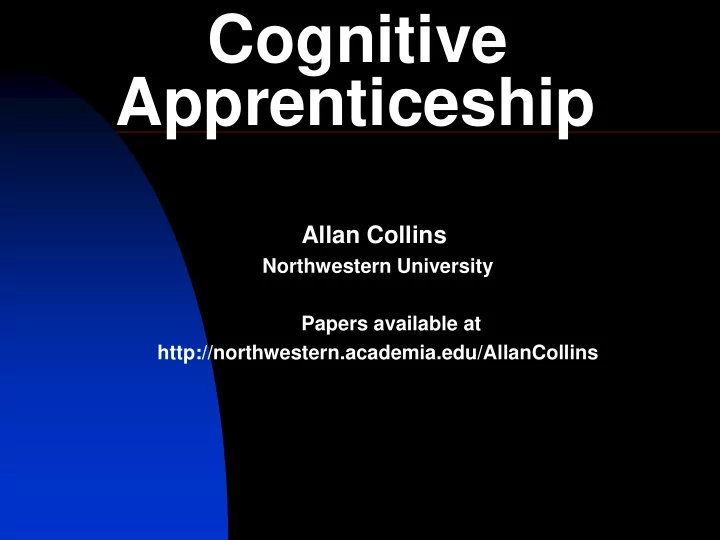

Cognitive Apprenticeship Allan Collins Northwestern University Papers available at http://northwestern.academia.edu/AllanCollins
Features of Apprenticeship Apprenticeship is the way we learned before schooling • Unlike school, apprenticeship embeds learning in the • social and functional contexts of its use Lave emphasizes observation, coaching, and practice • or in our terms modeling , coaching, scaffolding, and fading Essence of apprenticeship method is to start out • providing a highly structured environment and slowly turning over control to the learner Master knows learner well reducing failure • Technology makes it possible to realize • apprenticeship method much more widely
Differences between Cognitive and Traditional Apprenticeship Tasks chosen to reflect the changing demands of • learning rather than what comes in the door Learning set in diverse contexts to foster generalization • rather than constrained to a particular work setting Making thinking visible rather than relying on • observation of physical skills
Framework for Designing Cognitive Apprenticeship Environments (1) Content: types of knowledge required for expertise • Domain knowledge: subject matter specific concepts, facts, and procedures • Heuristic strategies: generally applicable techniques for accomplishing tasks • Control strategies: general approaches for directing one’s solution process • Learning strategies: knowledge about how to learn new concepts, facts, and procedures
Framework for Designing Cognitive Apprenticeship Environments (2) Method: ways to promote the development of expertise • Modeling: teacher performs a task so students can observe • Coaching: teacher observes and facilitates while students perform a task • Scaffolding: teacher provides supports to help the student perform a task • Articulation: teacher encourages students to verbalize their knowledge and thinking • Reflection: teacher enables students to compare their performance with others • Exploration: teacher invites students to pose and solve their own problems
Framework for Designing Cognitive Apprenticeship Environments (3) Sequence: keys to ordering learning activities • Increasing complexity : meaningful tasks gradually increasing in difficulty • Increasing diversity: practice in a variety of situations to emphasize broad application • Global before local skills: focus on conceptualizing the whole task before executing the parts
Framework for Designing Cognitive Apprenticeship Environments (4) Sociology: social characteristics of learning environments • Situated learning: students learn in the context of working on realistic tasks • Community of practice: communication about different ways to accomplish meaningful tasks • Intrinsic motivation : students set personal goals to seek skills and solutions • Cooperation: students work together to accomplish their goals
Benefits of Situated Learning • Learners understand the uses and purpose of what they are learning • They learn while actively using knowledge rather than passively receiving knowledge • They learn the different conditions where the knowledge can be applied • Learning in multiple contexts fosters generalization
Metaphor to Learning Tennis • School is like having learners practice hitting serves, backhands and forehands, and volleys without playing games or even watching games • A tennis coach will teach these skills but interweave this practice with playing games • The coach will determine what skills you need to work on, provide hints as to strategies to apply, and find challenging opponents to play against
Model for Cognitive Apprenticeship in a Project-based Curriculum Novice: Students come in as novices and work on a project of their own with one of the more experienced students mentoring them, as they carry out the project. Apprentice: As they gain experience, they work on larger projects with other students, where more advanced students serve as project and subproject leaders. Mentor: After they have worked on a number of different projects, they are ready to serve as a mentor for a new incoming student. Project leader: After they have done their mentoring successfully, they are ready to begin serving as a project or subproject leader on larger projects.
Benefits of Technology for Creating Apprenticeship Learning Environments Situated learning Modeling Coaching Scaffolding Articulation Reflection Intrinsic motivation
Recommend
More recommend